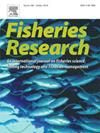Twenty years of AFORO: New developments and connections enhancing otolith research
IF 2.2
2区 农林科学
Q2 FISHERIES
引用次数: 0
Abstract
Since 2003, with the aim of addressing different issues related to otoliths and the advancement of technologies, AFORO acronym of Anàlisi de FORmes d’Otòlits (otolith shape analysis), a computational environment with a set of tools including a website for this purpose, has gradually expanded its functionality. This implies different ways to measure otoliths in order to obtain different types of information of the same individual. The 2D otoliths shape description using different methods permits the comparison between classical methods and the Wavelet transform, used in the automatic classification system of AFORO. The 3D otoliths description in a few images opens the possibility of classifications using volumetric information, which they have performed well. The data of relationships between otolith and fish length in AFORO is used in predator-prey studies. Our website offers the possibility to display otolith georeferencing information interactively. Furthermore, the automatic classification system has been improved by incorporating geographic filters based on georeferenced data. The diverse information that AFORO offers on the otoliths opens the possibility to approach new studies or to improve the existing ones, combining this information or applying the most appropriate one to the specific problem. Classification cases with Wavelets that have been improved by introducing geographical area information will be presented. In addition, Deep Learning algorithms will be introduced by performing classifications with a small subset of otoliths of species which contain a sufficient number of specimens (>8).
求助全文
约1分钟内获得全文
求助全文
来源期刊

Fisheries Research
农林科学-渔业
CiteScore
4.50
自引率
16.70%
发文量
294
审稿时长
15 weeks
期刊介绍:
This journal provides an international forum for the publication of papers in the areas of fisheries science, fishing technology, fisheries management and relevant socio-economics. The scope covers fisheries in salt, brackish and freshwater systems, and all aspects of associated ecology, environmental aspects of fisheries, and economics. Both theoretical and practical papers are acceptable, including laboratory and field experimental studies relevant to fisheries. Papers on the conservation of exploitable living resources are welcome. Review and Viewpoint articles are also published. As the specified areas inevitably impinge on and interrelate with each other, the approach of the journal is multidisciplinary, and authors are encouraged to emphasise the relevance of their own work to that of other disciplines. The journal is intended for fisheries scientists, biological oceanographers, gear technologists, economists, managers, administrators, policy makers and legislators.
 求助内容:
求助内容: 应助结果提醒方式:
应助结果提醒方式:


